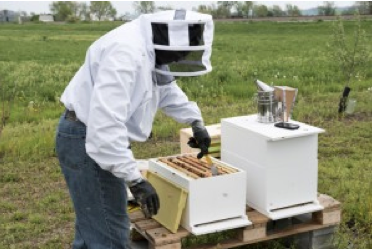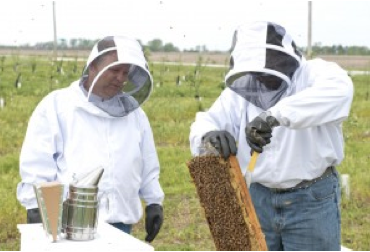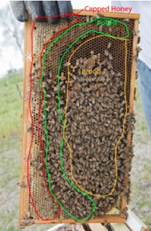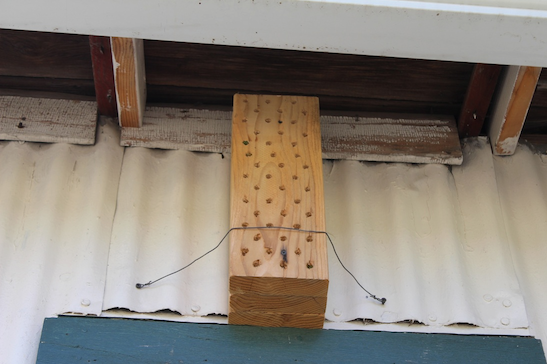Pollination & Honeybees
Pollination is required to produce fruit. Most Midwest fruit trees in the US are pollinated by bees. Some fruit varieties are self-pollinating while others require two varieties for cross-pollination. Our orchard’s pollination comes from two honeybee colonies that each contain 60,000 bees. We also provide nesting sites for solitary mason (orchard) bees. Honeybees are provided by Jawara James.
For more information and the importance of bees, see the following websites:
For more information and the importance of bees, see the following websites:
Mason Bee Facts
|
|
Honey Bee Facts
|
| ||||||
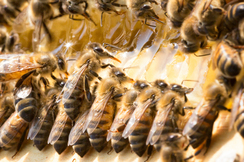
The Hive
- A honey bee colony can contain up to 60,000 bees at its peak (20,000 - 30,000 bees in the winter, and over 60,000 - 80,000 bees in the summer)
- Honey bees maintain a constant temperature of about 93F within the hive year-round.
- As temperatures fall, the bees do not hibernate but rather form a tight cluster within the hive to stay warm. Bees will disconnect their wings allowing then to pump their wing muscles to create heat
- In summer, the workers fan the air with their wings to stay cool
- Bees fly outside the hive normally when temperatures rise above 50 degrees
- Honeybee colonies have unique odors that members flash like ID cards at the hive's front door, so the guard bees can recognize the entering bees
- Beehives are kept on farms, in backyards, on balconies, and high-rise rooftops, all across the country
- There are three castes of honeybee: queen, worker and drone
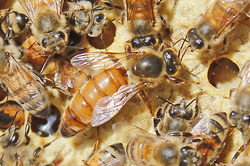
Queen Bee
- A queen honey bee stores a lifetime supply of sperm. She can live 3-5 years, but within her first 20 days, she must mate otherwise lose the ability to do so
- There is only one queen per hive
- The queen is the only bee with fully developed ovaries
- The queen mates only once with several male (drone) bees, and will remain fertile for life
- She lays up to 2000 eggs per day. Fertilized eggs become female (worker bees) and unfertilized eggs become male (drone bees)
- When she dies or becomes unproductive, the other bees will "make" a new queen by selecting a young larva and feeding it a diet of "royal jelly"
- For queen bees, it takes 16 days from egg to emergence
- The queen grows one and a half times larger than the ordinary bee, and is capable of laying up to two thousand eggs a day.
- The Queen Bee lives forty times longer than the bees on a regular diet. There is no difference between a queen bee and a worker bee in the larval stage. The only factor that is different between them is that a developing queen bee continues to eat only royal jelly.
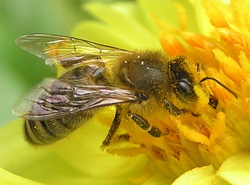
Worker Bee
- Workers are all females
- There can be between 40-60,000 in a strong hive
- There are several worker classifications: nurse bees care for the young, the queen's attendant workers bathe and feed her, guard bees stand watch at the door, construction workers build the beeswax foundation in which the queen lays eggs and the workers store honey, undertakers carry the dead from the hive and foragers must bring back enough pollen and nectar to feed the entire community
- Worker bees live for 6 weeks during the busy summer, and for 4-9 months during the winter months (they literally work themselves to death)
- All worker bees are female, but they are not able to reproduce.
- Nearly all of the bees in a hive are worker bees.
- The worker bees sequentially take on a series of specific chores during their lifetime: housekeeper; nursemaid (care for the young); construction worker (build beeswax foundation in which the queen lays eggs and the workers store honey); grocer; undertaker (carry the dead from the hive); guard (stand watch at the door); queen's attendants (bathe and feed the queen); and finally, after 21 days they become a forager collecting pollen and nectar to feed the entire community
- For worker bees, it takes 21 days from egg to emergence. The worker bee has a barbed stinger that results in her death following stinging, therefore, she can only sting once.
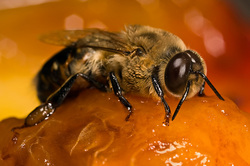
Drone Bee
- Drones are the only male honey bees.
- Their sole purpose is to provide sperm to the queen, which happens about one week after emerging from their cells
- These male bees are kept on standby during the summer for mating with a virgin queen.
- Because the drone has a barbed sex organ, mating is followed by death of the drone.
- There are only 300-3000 drones in a hive.
- The drone does not have a stinger.
- Because they are of no use in the winter, drones are expelled from the hive in the autumn.
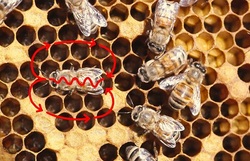
Communication
- The honey bee uses the most complex symbolic language of any animal on earth, outside of the primate family (Karl von Frisch received the Nobel Prize in Medicine in 1973 for cracking the language code of honey bees - the waggle dance)
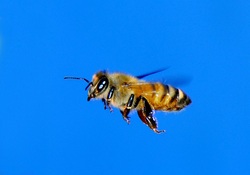
Travel
- Honey bees can fly at speeds of up to 15 miles per hour - their wings flap about 12,000 times per minute or 200 beats per second, creating the distinctive "buzz" that you hear
- Honeybees will usually travel approximately 3 miles from their hive
- It would take about 1 ounce of honey to fuel a honeybee's flight around the world
- An industrious worker bee may visit 2,000 flowers per day, visiting 50-100 flowers each time before heading home to unload the pollen. A hardworking forager may live just 3 weeks due to all the wear and tear on her body
- A hive of bees will fly 90,000 miles, the equivalent of three orbits around the earth to collect 1 kg of honey
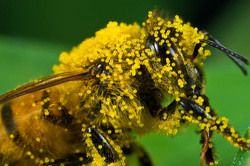
Pollen
- Bees collect 66 lbs of pollen per year, per hive. Pollen is the male germ cells produced by all flowering plants for fertilization and plant embryo formation. The Honeybee uses pollen as a food. Pollen is one of the richest and purest natural foods, consisting of up to 35% protein, 10% sugars, carbohydrates, enzymes, minerals, and vitamins A (carotenes), B1 (thiamin), B2 (riboflavin), B3 (nicotinic acid), B5 (panothenic acid), C (ascorbic acid), H (biotin), and R (rutine)
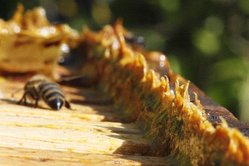
Propolis
- Collected by honeybees from trees, the sticky resin is mixed with wax to make a sticky glue. The bees use this to seal cracks and repair their hive. It is used by humans as a health aid, and as the basis for fine wood varnishes
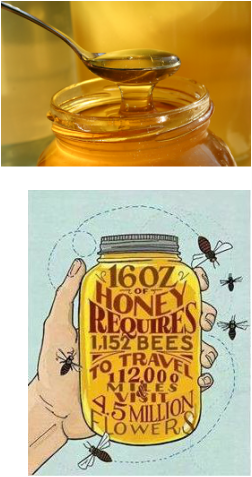
Honey
- Honey is used by the bees for food all year round. There are many types, colors and flavors of honey, depending upon its nectar source. The bees make honey from the nectar they collect from flowering trees and plants. Honey is an easily digestible, pure food. Honey is hydroscopic and has antibacterial qualities. Eating local honey can fend off allergies
- A single honey bee worker produces about 1/12th of a teaspoon of honey in her lifetime - to survive the winter, the workers must produce about 60 lbs. of honey and this takes tens of thousands of bees to get the job done
- A honeybee has to travel over 55,000 miles and visits approximately 2 million flowers to make 1 pound of honey
- Honey is the only food that includes all the substances necessary to sustain life, including water
- A typical beehive makes more than 400 pounds of honey per year
- Approximately 7-8 pounds of honey are consumed by bees to produce 1 pound of beeswax
- Honey speeds the healing process and combats infections
- Honey never spoils
- There are many varietals of honey. From orange blossom honey, award winning tupelo honey, clover, alfalfa, blueberry, to apple blossom.
- Honey comes as extracted, liquid, creamed. or in the comb.
- We only produce about 30% of the honey we consume in the U.S.
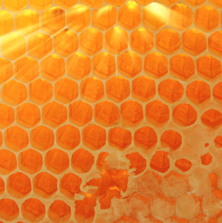
Beeswax
- Secreted from glands, beeswax is used by the honeybee to build honey comb. It is used by humans in drugs, cosmetics, artists' materials, furniture polish and candles
- Honey bees produce beeswax from special glands on their abdomens. They use this to construct honeycomb
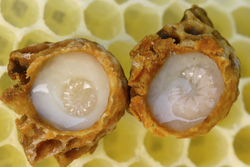
Royal Jelly
- The powerful, milky substance that turns an ordinary bee into a Queen Bee. It is made of digested pollen and honey or nectar mixed with a chemical secreted from a gland in a nursing bee's head. It commands premium prices rivaling imported caviar, and is used by some as a dietary supplement and fertility stimulant. It is loaded with all of the B vitamins.
- The larvae chosen to become a queen continue to eat only royal jelly
- In France, there have been reports of women fed royal jelly during menopause, showing complete remission of their symptoms. Some were even able to become mothers again. France also claimed that their studies showed royal jelly to have rejuvenating and sexually stimulating effects on both men and women. Canada has approved royal jelly as a natural dietary supplement for its athletes. Royal jelly is not a drug, but a nutritious, quickly assimilated food.
- In Germany, Drs. Chochi, Prosperi, Quadri and Malossi (in separate studies) used royal jelly as an aid to badly undernourished and premature babies. The infants fed royal jelly increased in weight and health. Another doctor, Telatui, reported that neuro-psychic patients given royal jelly regained normal weight, a more stable nervous system, and a greater degree of stamina for physical and mental work.
- Chemical analysis of royal jelly found it rich in protein and the B vitamins (especially panothenic acid). However, analysis of royal jelly fails to break it down into all its different components. It cannot be synthesized.
- It is a potent bactericide. It acts as a catalyst, stimulating intercellular metabolic activities without significantly modifying normal physiological activity. Thus, it hastens cell recovery with no side effects. Royal jelly has been known to speed up healing of wounds and to reduce the amount of scarring.
- The beneficial effects of royal jelly seem not to depend entirely upon its vitamin content, but upon some type of enzymatic or catalytic action of an as yet unknown factor; or perhaps, the known factors working in combination with a co-enzyme through a process that has not yet been defined.
- It has been recommended for a great variety of purposes: to retard the aging process, for menopause, correction of under-nutrition, for arthritis, vascular diseases, peptic ulcers, liver ailments, nervous instability, skin problems, improvement of sexual functions, general health and well being.
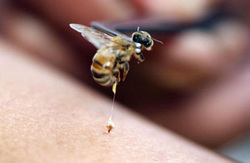
Bee Venom
- The "ouch" part of the honeybee. Although sharp pain and some swelling and itching are natural reactions to a honeybee sting, a small percentage of individuals are highly allergic to bee venom. "Bee venom therapy" is widely practiced overseas and by some in the USA to address health problems such as arthritis, neuralgia, high blood pressure, high cholesterol and even MS.
- Honeybees are not aggressive by nature, and will not sting unless protecting their hive from an intruder or are unduly provoked
- Honeybees are the only bees that die after they sting
- It is estimated that 1100 honey bee stings are required to be fatal
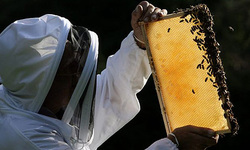
Beekeepers
- A beekeepers main tools are a protective veil, smoker, gloves, and a hive tool
- Smoke inhibits alarm pheromone from alerting other bees of danger. They will also gorge themselves with honey in preparation of fleeing a perceived wildfire, taking as much resources with them as possible.
- A beekeeper will harvest extra honey that bees store beyond what they need to survive.
- The record harvest for one colony is 404 pounds, by the Aebis Family in 1974
- For every 100 beekeepers, 95% are hobbyists, 4% sideliners, and 1% are fulltime or commercial beekeepers
- Beekeeping dates back at least 4500 years.
- Beekeeping can be a sustainable endeavor.
- Renting bees to farmers in need of pollination generates a source of income
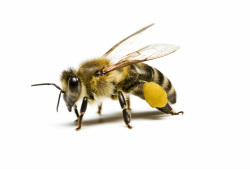
Other Facts
- Honey bees, scientifically also known as Apis mellifera, are environmentally friendly and are vital as pollinators
- Honey bees have 6 legs, 2 compound eyes made up of thousands of tiny lenses (one on each side of the head), 3 simple eyes on the top of the head, 2 pairs of wings, a nectar pouch, and a stomach
- The bee's brain is oval in shape and only about the size of a sesame seed, yet it has remarkable capacity to learn and remember things and is able to make complex calculations on distance travelled and foraging efficiency
- Honey bees have 170 odorant receptors, compared with only 62 in fruit flies and 79 in mosquitoes. Their exceptional olfactory abilities include kin recognition signals, social communication within the hive, and odor recognition for finding food. Their sense of smell is so precise that it could differentiate hundreds of different floral varieties and tell whether a flower carried pollen or nectar from metres away
- Honeybees are entirely herbivorous when they forage for nectar and pollen, but can cannibalize their own brood when stressed
- Honeybees are responsible for approx 80% of all fruit, vegetable and seed crops in the U.S. Without such pollination, we would see a significant decrease in the yield of fruits and vegetables
- Honeybees are the only insect that produce food for humans
- Honeybees are not native to the USA. They are European in origin, and were brought to North America by the early settlers
- The practice of honey collection and beekeeping dates back to the stone-age, as evidenced by cave paintings
- Honeybees are a great scientific mystery because they have remained unchanged for 20 million years even though the world has changed around them
- Each honey bee colony has a unique odor for members' identification
Movie Recommendation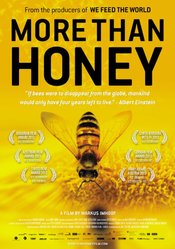
Title: More Than Honey (2012)
Type: Documentary Length: 95 minutes Buy on Amazon: Click here Also available on Netflix An in-depth look at honeybee colonies in California, Switzerland, China and Australia. |
Trailer - "More Than Honey" |

